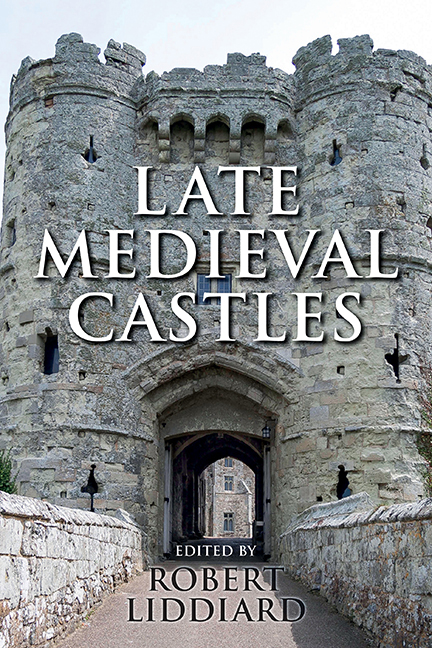Book contents
- Frontmatter
- Contents
- List of Illustrations
- Acknowledgements
- Editor's Preface
- List of Abbreviations
- A Note on the Text
- Introduction
- 1 Fourteenth-Century Castles in Context: Apotheosis or Decline?
- 2 Architects, Advisors and Design at Edward I's Castles in Wales
- 3 The Courtyard and the Tower: Contexts and Symbols in the Development of Late Medieval Great Houses
- 4 Castle Planning in the Fourteenth Century
- 5 Meaningful Constructions: Spatial and Functional Analysis of Medieval Buildings
- 6 Mota, Aula et Turris: The Manor-Houses of the Anglo-Scottish Border
- 7 Lulworth Castle, Dorset
- 8 A Scottish Problem with Castles
- 9 Structural Symbolism in Medieval Castle Architecture
- 10 Specimens of Freedom to Crenellate by Licence
- 11 Some Analysis of the Castle of Bodiam, East Sussex
- 12 English Castles in the Reign Of Edward II
- 13 Castles of Ward and the Changing Pattern of Border Conflict in Ireland
- 14 The Donjon Of Knaresborough: The Castle As Theatre
- 15 The Architecture of Arthurian Enthusiasm: Castle Symbolism in the Reigns of Edward I and his Successors
- 16 Medieval Ornamental Landscapes
- 17 Otherworld Castles in Middle English Arthurian Romance
- Guide to Further Reading
- Index
15 - The Architecture of Arthurian Enthusiasm: Castle Symbolism in the Reigns of Edward I and his Successors
Published online by Cambridge University Press: 29 April 2017
- Frontmatter
- Contents
- List of Illustrations
- Acknowledgements
- Editor's Preface
- List of Abbreviations
- A Note on the Text
- Introduction
- 1 Fourteenth-Century Castles in Context: Apotheosis or Decline?
- 2 Architects, Advisors and Design at Edward I's Castles in Wales
- 3 The Courtyard and the Tower: Contexts and Symbols in the Development of Late Medieval Great Houses
- 4 Castle Planning in the Fourteenth Century
- 5 Meaningful Constructions: Spatial and Functional Analysis of Medieval Buildings
- 6 Mota, Aula et Turris: The Manor-Houses of the Anglo-Scottish Border
- 7 Lulworth Castle, Dorset
- 8 A Scottish Problem with Castles
- 9 Structural Symbolism in Medieval Castle Architecture
- 10 Specimens of Freedom to Crenellate by Licence
- 11 Some Analysis of the Castle of Bodiam, East Sussex
- 12 English Castles in the Reign Of Edward II
- 13 Castles of Ward and the Changing Pattern of Border Conflict in Ireland
- 14 The Donjon Of Knaresborough: The Castle As Theatre
- 15 The Architecture of Arthurian Enthusiasm: Castle Symbolism in the Reigns of Edward I and his Successors
- 16 Medieval Ornamental Landscapes
- 17 Otherworld Castles in Middle English Arthurian Romance
- Guide to Further Reading
- Index
Summary
The castles of King Edward I in North Wales have long been acknowledged as one of the crowning achievements of European military architecture. They mark the culmination of almost two centuries of development, from the first crusading experience in the Near East, through the castles of the Plantagenets and Philip Augustus in France; resulting in virtually impregnable fortresses relying on such features as concentric walls and heavily fortified gatehouses. The Edwardian castles are a virtuoso demonstration of such ideas, characterised especially by their enormity of scale and their variety of type. Flint has a detached keep, Conwy is planned for consecutive defence, Harlech and Beaumaris rely on concentric defences of near perfect symmetry; Caernarfon experiments with polygonal towers, Conwy with a very early example of stone machicolation, and so on. The impression is firmly given of an elite group of men-of-war, long-standing comrades in arms of the king, indulging in an orgy of military architectural expression on an almost unlimited budget: a medieval forerunner of the American ‘star-wars’ programme.
No-one doubts that the English castles in North Wales represent an overkill. One has only to compare a castle of the Welsh princes, such as Dolbadarn in Snowdonia, with Harlech or Conwy to gain a visual appreciation of this phenomenon (Figures 4, 5, 6). Clearly the explanation for these excesses goes beyond basic military function, and two further motives will be examined here – artistic effect and symbolism – as exemplified particularly at Caernarfon, the viceregal centre of the English administration after 1284. The idea that real castles might also incorporate decoration found no place in Sidney Toy's style of military history, but Caernarfon displays a series of features that can be construed as consciously artistic. Decoration can be observed earlier in the fabric of some Anglo-Norman keeps, like that at Castle Rising, Norfolk (c.1140), and modern research has heightened our awareness of such factors at work in the twelfth century. Nevertheless, the extent of the decorative vocabulary at Caernarfon marks it out as a turning point: the progenitor of the late medieval castle as a work of art.
- Type
- Chapter
- Information
- Late Medieval Castles , pp. 349 - 374Publisher: Boydell & BrewerPrint publication year: 2016



